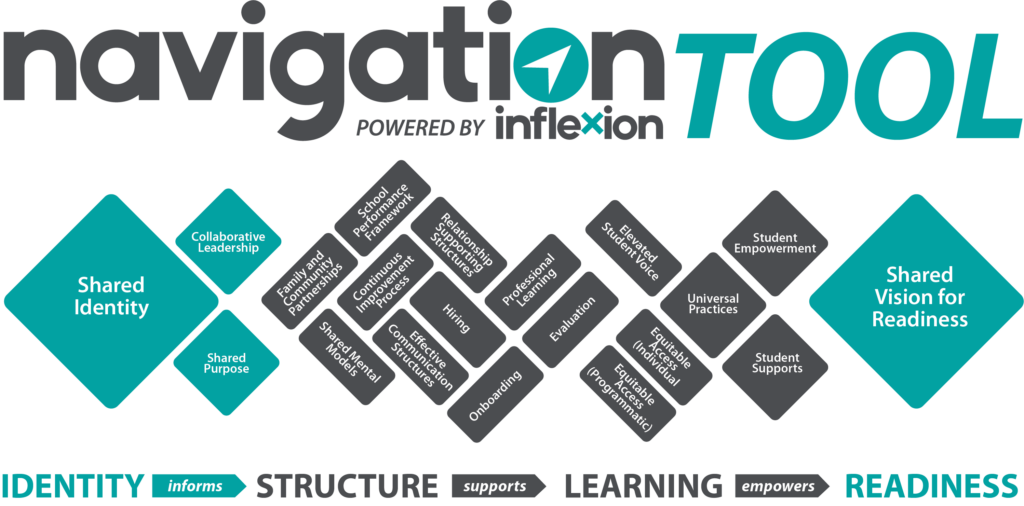Bridging the Gap From What to How

It always takes a group of people working together with a common purpose in an atmosphere of trust and collaboration to get extraordinary things done.
– James M. Kouzes

INTRO
The Navigation Tool empowers community school leaders by providing clear, actionable guidance that translates Capacity Building Strategies—defining what needs to be done—into practical, step-by-step processes, showing how to effectively implement and sustain those strategies for transformative outcomes.
OBJECTIVES
- Understand how the Navigation Tool helps community school leaders move from broad Capacity Building Strategies to step-by-step, practical implementation, ensuring sustainable and transformative outcomes
The following provides a crosswalk between the five Capacity Building Strategies and specific components from the Navigation Tool.
Shared Commitment, Understanding, and Priorities
The Navigation Tool provides a robust framework for fostering Shared Commitment, Understanding, and Priorities within community school implementation by aligning interest-holders around a clear and actionable vision. Through its emphasis on Shared Identity and Shared Purpose, it guides schools in defining collective values, beliefs, and outcomes that reflect the needs of their entire community, ensuring all voices are heard and represented. The tool promotes Collaborative Leadership, encouraging inclusive decision-making processes that engage diverse interest holders—students, families, and staff—while prioritizing those whose voices are often marginalized. By embedding Effective Communication Structures, it establishes transparent, bi-directional communication channels that build trust and ensure alignment with shared goals. The integration of Family and Community Partnerships ensures that schools purposefully collaborate with families and community organizations to meet the needs of every student, while the Continuous Improvement Process utilizes diverse, disaggregated data to identify and address disparities, enabling schools to set and monitor collective priorities. Together, these elements empower schools to cultivate authentic relationships, build a united vision, and create the conditions necessary for transformative, community-driven outcomes.
Centering Community-Based Learning
The Navigation Tool provides a comprehensive framework to support Centering Community-Based Learning (CBL) by fostering learning environments that are relationship-centered and rooted in the diverse cultural and linguistic backgrounds of students, families, and educators. Through its focus on Shared Identity and Family and Community Partnerships, the tool ensures that schools leverage community assets, cultural wealth, and funds of knowledge to create inclusive and meaningful learning experiences. By prioritizing Student Empowerment and Elevated Student Voice, the framework emphasizes the importance of connecting classroom instruction to real-life experiences and addressing issues relevant to students’ lives and communities. This alignment cultivates a sense of belonging and agency, enabling students to see themselves and their communities reflected in their learning. Additionally, Effective Communication Structures and Relationship Supporting Structures promote trust and authentic engagement between interest-holders, reinforcing the collaborative nature of CBL. By embedding these practices, the Navigation Tool empowers schools to center instruction around community-based learning, enhancing student engagement and ownership while honoring and building upon the rich cultural and ways of knowing within their communities.
Collaborative Leadership
The Navigation Tool effectively supports capacity-building strategies like Shared Decision-Making by embedding structures and practices that ensure all stakeholders have a voice in the transformation process. Through its focus on Collaborative Leadership, the tool promotes an inclusive decision-making model that disrupts traditional hierarchies and fosters supportive relationships among students, families, staff, and the broader community. By engaging key influencers and prioritizing voices often underrepresented, it ensures that decisions are equitable, widely accepted, and aligned with the Shared Vision for Readiness. Additionally, the tool’s emphasis on transparent and Effective Communication Structures strengthens trust and coordination, enabling seamless alignment of programs and strategies. The framework further supports innovative, out-of-the-box thinking by integrating diverse perspectives through its Continuous Improvement Process, which uses disaggregated data and empathy-driven approaches to tackle complex challenges. These elements not only enhance decision-making but also ensure the sustainability of efforts, empowering schools to implement collaborative solutions that are deeply rooted in the needs and priorities of their community.
Sustaining Staff and Resources
The Navigation Tool provides critical support for Sustaining Staff and Resources by embedding systems and processes that ensure the longevity and alignment of the community school vision and strategy. Its emphasis on Hiring prioritizes recruiting candidates who align with the Shared Identity, Mental Models, and Vision for Readiness, ensuring that staff contribute to the collective mission. The Onboarding process further reinforces this alignment by introducing new staff to the school’s Shared Purpose, Universal Practices, and rituals that foster equity and connection, ensuring their integration into the community is intentional and supportive.
Additionally, the tool’s focus on Professional Development ensures that learning opportunities for staff are aligned with the school’s holistic vision and designed to build capacity for serving systematically disadvantaged students. By embedding adult learning theory and maximizing the use of time, professional development remains both impactful and sustainable. Evaluation processes ensure coherence by aligning performance assessments with the school’s shared vision, identity, and instructional practices, reinforcing the collective focus and accountability necessary for sustained progress.
Strategic Community Partnerships
The Navigation Tool supports Strategic Community Partnerships by providing a structured framework for schools and LEAs to build trusting, collaborative relationships that expand their capacity to achieve the shared vision of interest-holders. Through its focus on Family and Community Partnerships, the tool emphasizes the development of robust systems and processes to cultivate meaningful collaborations with community-based organizations and families, aligning these partnerships with the school’s Shared Identity and Shared Vision for Readiness. This ensures that resources and efforts reflect the values, beliefs, and aspirations of the community while addressing holistic outcomes for all students.
The tool also integrates principles of Equitable Access, both individually and programmatically, ensuring that partnerships prioritize the needs, interests, and identities of students and families furthest from opportunity. By linking supports provided through community partnerships directly to the Universal Practices employed in classrooms, schools can ensure that these efforts are cohesive, consistent, and impactful. By aligning programmatic offerings and supports to the shared vision for readiness, partnerships can help address barriers to access, such as cost, transportation, and cultural responsiveness, while sustaining a diverse range of opportunities for all students. Additionally, the tool’s Effective Communication Structures and Relationship Supporting Structures foster transparency and engagement, ensuring that partnerships are built on trust and mutual understanding. This alignment enables strategic community partners to strengthen and support a broad continuum of priorities, from expanded learning opportunities to integrated student and family supports. Ultimately, by anchoring these collaborations in shared identity and readiness goals, the Navigation Tool empowers schools to leverage partnerships for sustainable, equitable, and transformative outcomes.
Inflexion Approach
The Inflexion Approach illustrates the critical components shared by all effective schools–Shared Identity and Shared Vision for Readiness–and the importance of alignment. A Shared Identity ensures that the school community collectively understands who they are and what they value, fostering a sense of belonging and purpose across students, families, and staff. A Shared Vision for Readiness defines the holistic outcomes the community prioritizes for all students, balancing skills, knowledge, and dispositions needed for success in life beyond school. These two foundational elements come to life through alignment, where systems, structures, and approaches to learning reflect the shared identity and actively support the shared vision. The Inflexion Approach empowers leaders and leadership teams to see the forest through the trees by emphasizing the interconnectedness of these components, helping them build or rebuild systems where every part contributes to a unified and coherent strategy. This coherence amplifies the power of their work, ensuring that critical components work seamlessly together to drive meaningful, sustainable outcomes.

Navigation Tool
The Navigation Tool serves as a step-by-step guide to help school leaders operationalize the Inflexion Approach through their Shared Identity, Shared Vision for Readiness, and alignment. By offering a clear roadmap, the tool enables leaders and leadership teams to maintain focus on the bigger picture while managing the complexities of daily operations, ensuring they can build interconnected systems that promote coherence across their schools. It provides practical, actionable processes to establish a cohesive school identity, engage stakeholders in defining a shared purpose, and align systems and structures to support learning that reflects these priorities. This emphasis on coherence ensures that every decision, practice, and structure works in harmony to advance the school’s shared vision. The Navigation Tool allows leaders to move beyond isolated efforts, creating a holistic, integrated approach that strengthens their ability to deliver equitable and impactful outcomes for all students.

About the Author
Dr. Matt Coleman is the CEO of Inflexion, where he leverages his deep-rooted expertise in school systems change to drive impactful educational reform. With a career spanning various roles—from educational assistant to assistant superintendent—Matt’s experience encompasses every level of secondary education.
Connect With Matt
Stay in the Loop
Subscribe to Our Newsletter
This work by Inflexion is licensed under Creative Commons Attribution-NonCommercial-ShareAlike 4.0 International







Responses